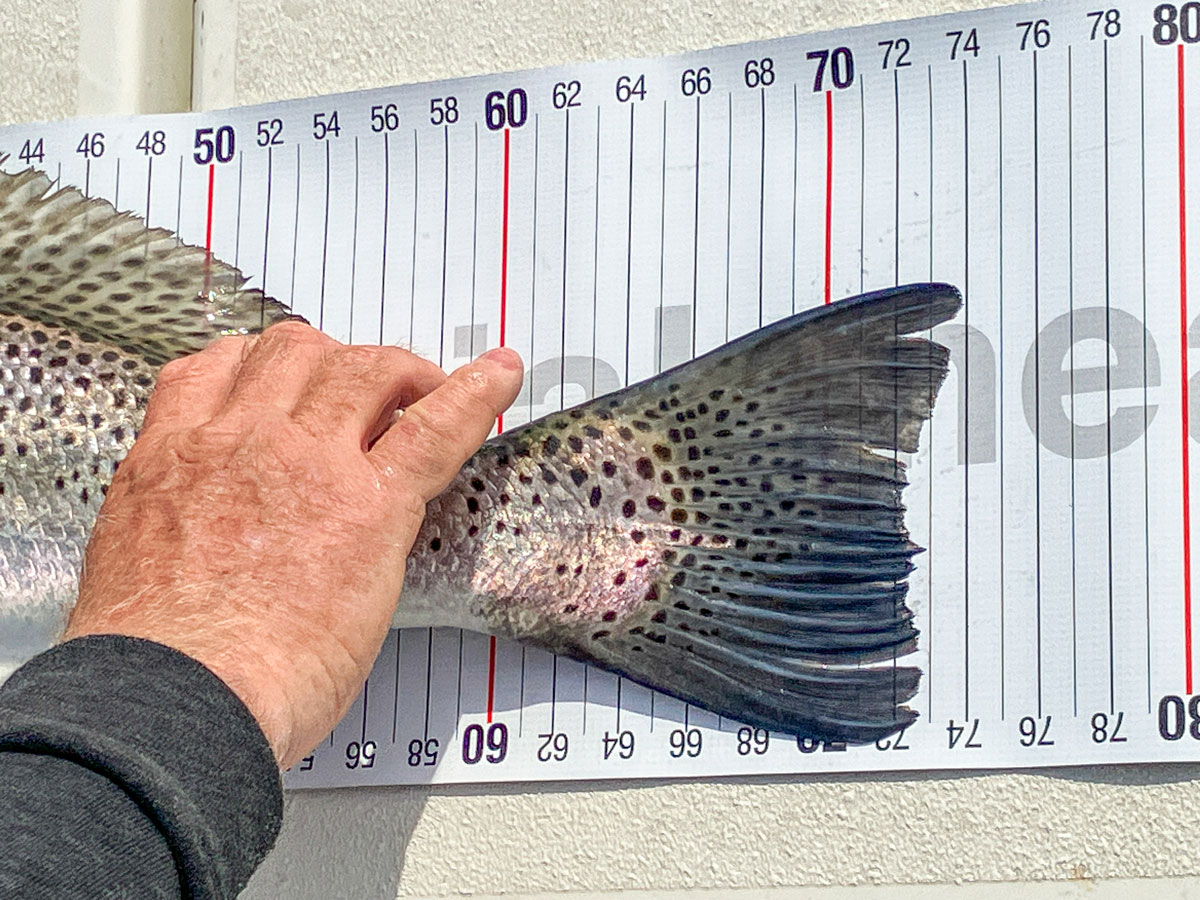by Captain Wayne MacMasters
Most of each year I fish for honest fish. From spring to November, speckled trout here in Virginia act like they ought to act. They are where they should be, on ledges or next to hard dark bottom close to the same depths they were in yesterday. They will eat when the water is the right color, the current is the right speed, bait is present, and the light is low. If it’s dead slack tide and there is no current, grab a sandwich and a beer, put your feet up, and relax. These spotted beauties aren’t going to eat. Same if the current is absolutely cranking. Better to find more moderately moving water. The solunar tables for a particular area are usually about right, too; major and minor feeds correlate to good bite times, and between times might be slow. Give that fly some action, strip set if you can remember to, and you’ll be tied into a nice speck.
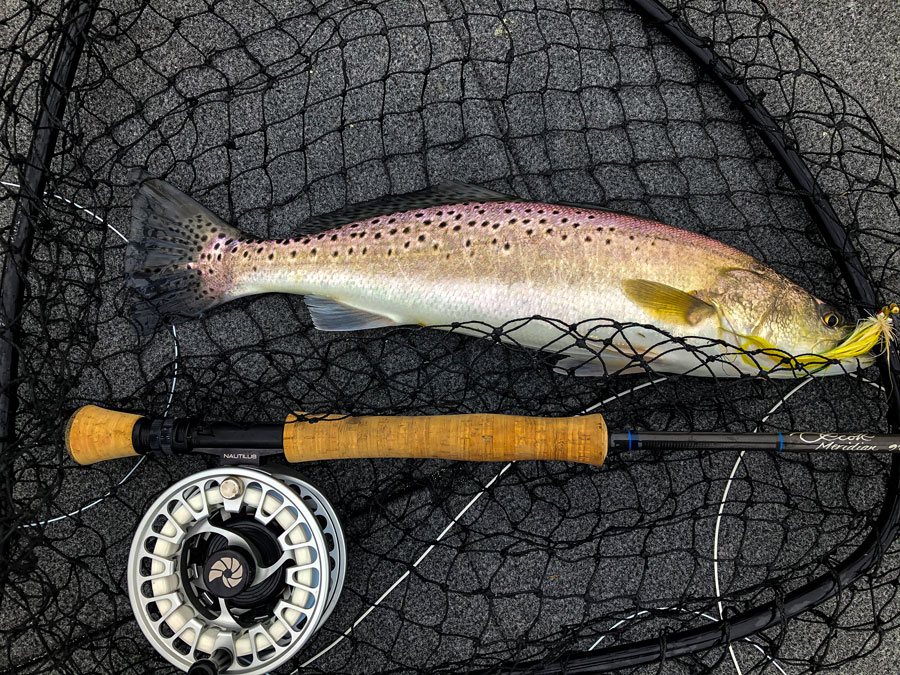 That all changes come December. Winter speckled trout go rogue. Once water temperatures drop into the low 50s, the game changes. Small specks move out to more stable temps in the mouth of Chesapeake Bay and the inshore Atlantic Ocean. Big speckled trout take the opposite approach, pushing up into the back of the lower bay’s rivers and creeks, in deep holes next to mudflats, where they slide up and onto them to reap the thermal benefit of dark mud warmed by an afternoon sun. Speckled trout can withstand temps into the low 40s (and even into the high 30s for a short time), but their metabolism drops, and they become hard to catch.
That all changes come December. Winter speckled trout go rogue. Once water temperatures drop into the low 50s, the game changes. Small specks move out to more stable temps in the mouth of Chesapeake Bay and the inshore Atlantic Ocean. Big speckled trout take the opposite approach, pushing up into the back of the lower bay’s rivers and creeks, in deep holes next to mudflats, where they slide up and onto them to reap the thermal benefit of dark mud warmed by an afternoon sun. Speckled trout can withstand temps into the low 40s (and even into the high 30s for a short time), but their metabolism drops, and they become hard to catch.
In the winter, these big fish are just plain tough to catch on fly. Perhaps even a bit dishonest. They will suspend in 20 feet of water one day, lie on the bottom in a 6- to 8-foot slough the next, and roam a mudflat the next. The day after you find them on a mudflat, you can have consistent weather and yet they’re nowhere to be found. Figuring out a pattern is challenging, and you must put the time in to be there when the bite happens. But when it does, it is all worth it.
Big speckled trout are, ahem, spectacular. Our conventional brethren have figured this out, and an addicted and passionate bunch fish tirelessly for large speckled trout day and night, year round, from Texas to Florida and up the Atlantic seaboard to Virginia. Big specks thump a fly as hard as any inshore fish. They are stunning, beautiful fish. They will fight you on the surface and they will fight you deep. They run fast—for 10 feet. Then they shake their head and tail walk, trying to throw the hook. They bulldog a few times, and the really big ones can straighten a hook or pop a 12-pound leader. Once hooked, they become unbuttoned as frequently as any big fish we target in the lower Chesapeake Bay, far more often than cobia, redfish, and striped bass. Targeting big speckled trout means, at some point, losing a big speckled trout. It’s going to happen.
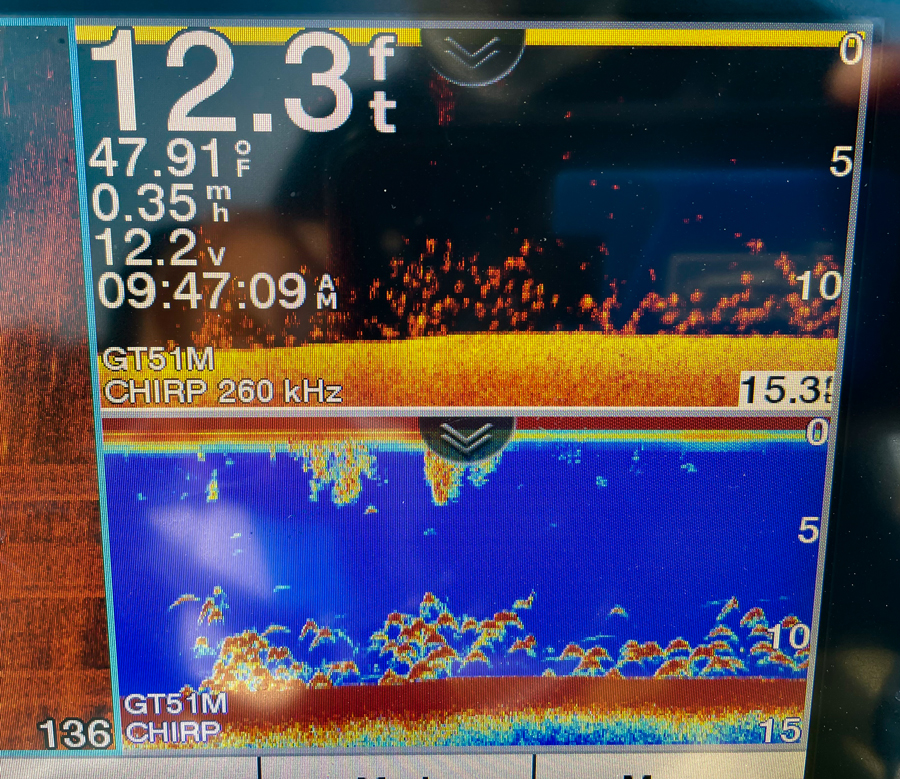
Effective use of electronics is one key to success. Depending on depth, I set my side scanner to 50 to 100 feet on each side and select a split screen displaying both side- and down-scanners. Look for marks on both screens. Once you locate fish in a specific location and depth, boat positioning, weapon selection, and instructions to the angler become precise for the situation at hand. Keep in mind that multiple marks may indicate average-sized trout, and trophy trout may be seen on your side scanner or with live-scan as singles lying in shallower water and tighter to structure. Our last two big trout (28.5 inches and 29.5 inches) this year were both caught immediately down current from points and piers.
What makes big speckled trout even more fun is the variety of ways we target them. A lot of our speck fishing is in 5 to 10 feet with moderate current. These fish usually hold in the lower half of the water column. Intermediate sinking lines on 7-weights work well with weighted Deceivers and other streamer and baitfish patterns. Freshwater streamer anglers do well in this scenario by slowing down their retrieve and transitioning to fishing the swing as the fly gets pulled down current.
If the fish are deeper, say 12 to 15 feet, Euro nymph or indicator dead-drift setups work well. We use 10-foot rods with long, light leaders and horizontally balanced flies. These flies are tied on 60-degree jig hooks. A standard pin or stainless-steel shaft with one or two tungsten beads is tied to the hook shank to protrude forward and balance the fly so that it rides hook up and horizontal, mimicking a swimming baitfish. Depending on the depth of water where the fish are holding, leader length varies from 1.25 to 1.5 times the intended target depth of the fly. Two flies work better than one. The lower fly should be heavier, larger, and darker than the top fly. Kelly Galloup’s dropper rig nymph fishing setup works great in this scenario. Indicators are optional but work especially well when fish are lying in faster current. There are several indicators available on the market, but the New Zealand Indicator is easy to use and casts better than bobber-type indicators.
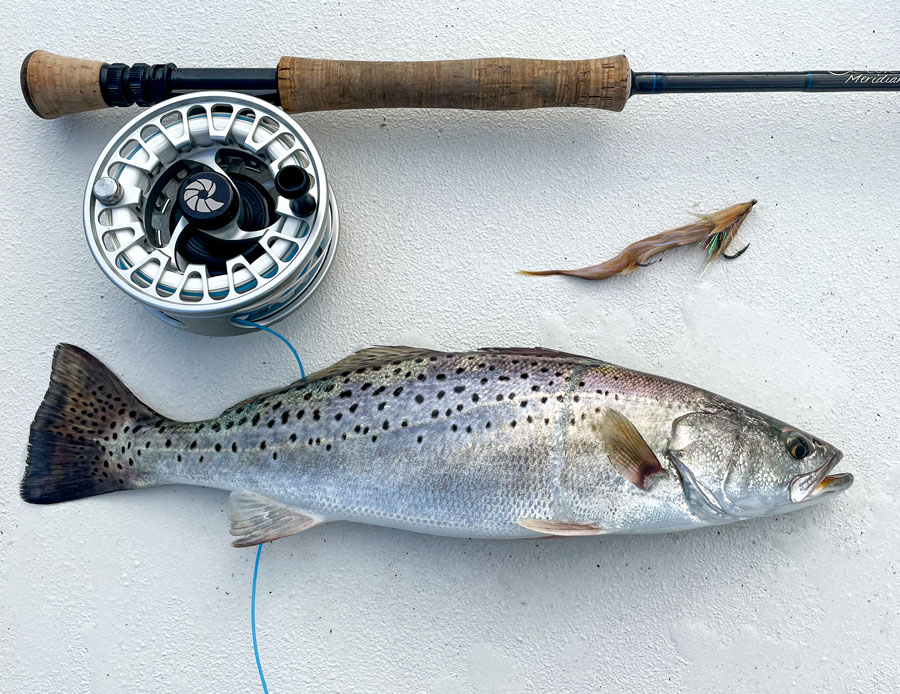 Heavy sink lines are also in play. T8 to T10 lines work well, with short fluorocarbon leaders and heavy flies, like the Half and Half tied with heavy lead dumbbell eyes. The fly should sink slightly faster than the fly line. Discipline with the countdown method is a must. Casting distance shouldn’t exceed your ability to manage your fly line, fly depth and retrieve speed. Figure out what depth the fish are holding based on electronics. A speckled trout will rarely swim down to hit a bait, so strip the fly slightly higher than the fish. Retrieves are typically painfully slow, and as the fly reaches the swing, a successful retrieve slows even more. A hit frequently will occur as the fly is hanging in the current.
Heavy sink lines are also in play. T8 to T10 lines work well, with short fluorocarbon leaders and heavy flies, like the Half and Half tied with heavy lead dumbbell eyes. The fly should sink slightly faster than the fly line. Discipline with the countdown method is a must. Casting distance shouldn’t exceed your ability to manage your fly line, fly depth and retrieve speed. Figure out what depth the fish are holding based on electronics. A speckled trout will rarely swim down to hit a bait, so strip the fly slightly higher than the fish. Retrieves are typically painfully slow, and as the fly reaches the swing, a successful retrieve slows even more. A hit frequently will occur as the fly is hanging in the current.
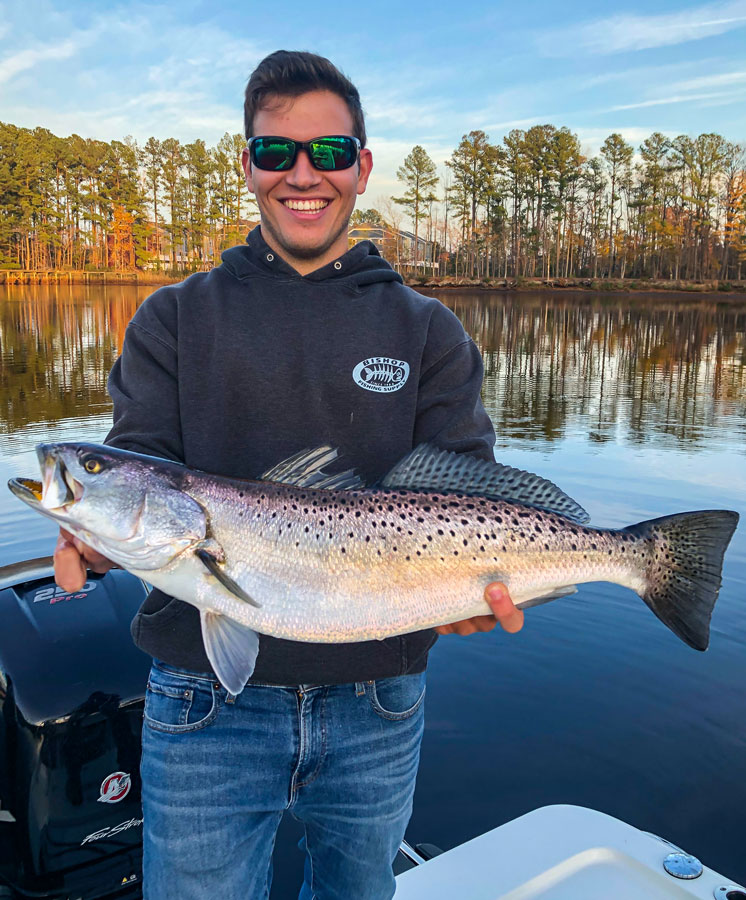
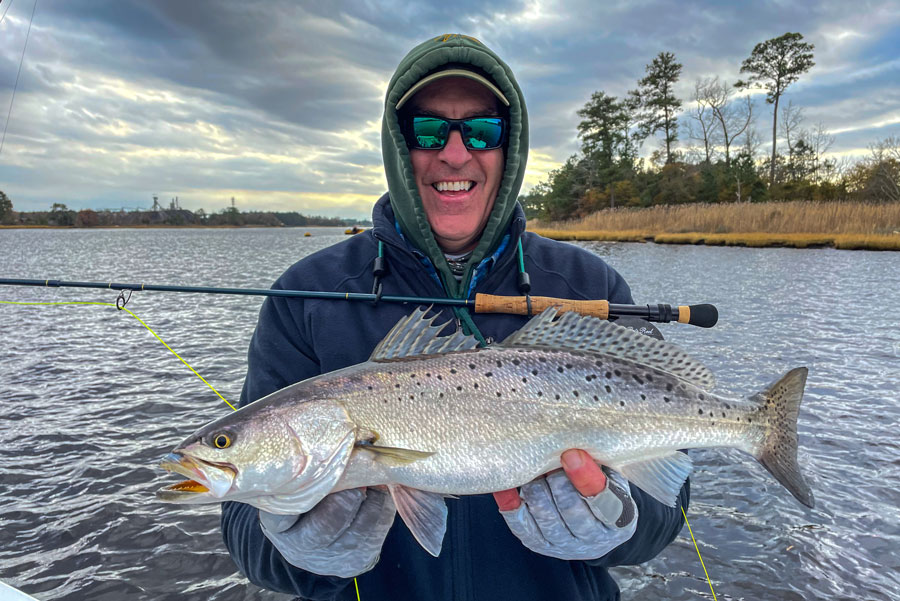
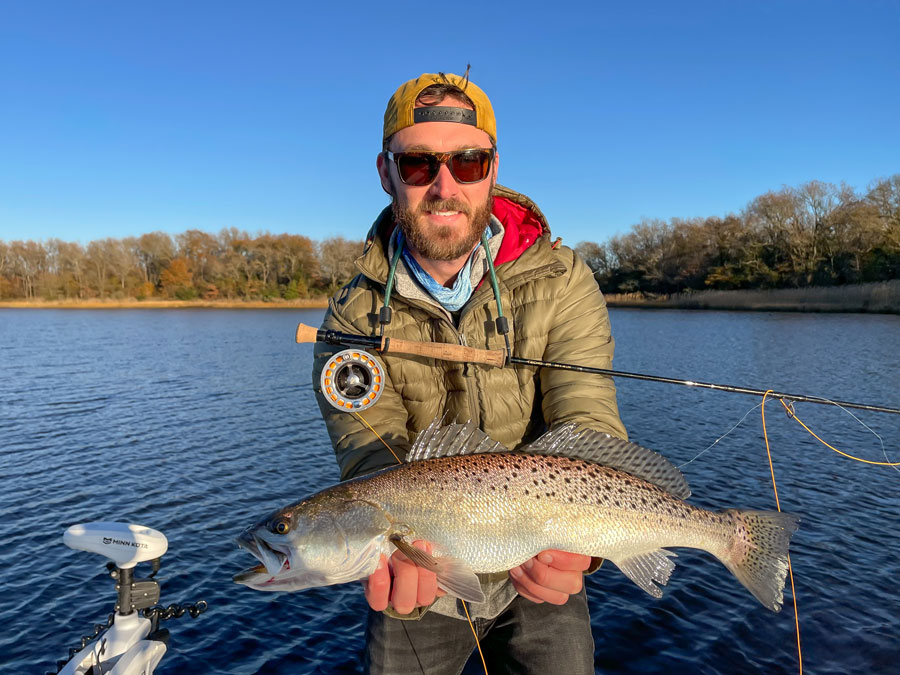
Mudflats throughout Hampton Roads offer the opportunity to catch big specks on floating lines. On some afternoons and even some mornings with high water, fish can be found in less than 2 feet of water on mudflats situated near deep water—in this scenario, 7-weights, floating lines, and streamer patterns are the ticket. Specks will be stationed in current off points and sloughs. A slow but erratic retrieve is needed to elicit a strike. Winter redfish are a fun “bycatch,” and might get you into your backing, which is something even big speckled trout don’t usually do.
When you do everything right and a big speckled trout hits a fly, it usually strikes hard. Despite being in the drum family, speckled trout act a lot like their sweetwater namesake. Although a strip-strike is preferred, feel free to trout-set, because I have come to appreciate that you can trout-set a trout.
The Virginia Saltwater Fishing Tournament program offers a recognition plaque for speckled trout over 24 inches that are released alive. Nearly all of these large speckled trout are females and critical to future stocks, so harvesting specks over 22 inches is discouraged.
SUBSCRIBE TO TAIL FLY FISHING MAGAZINE


